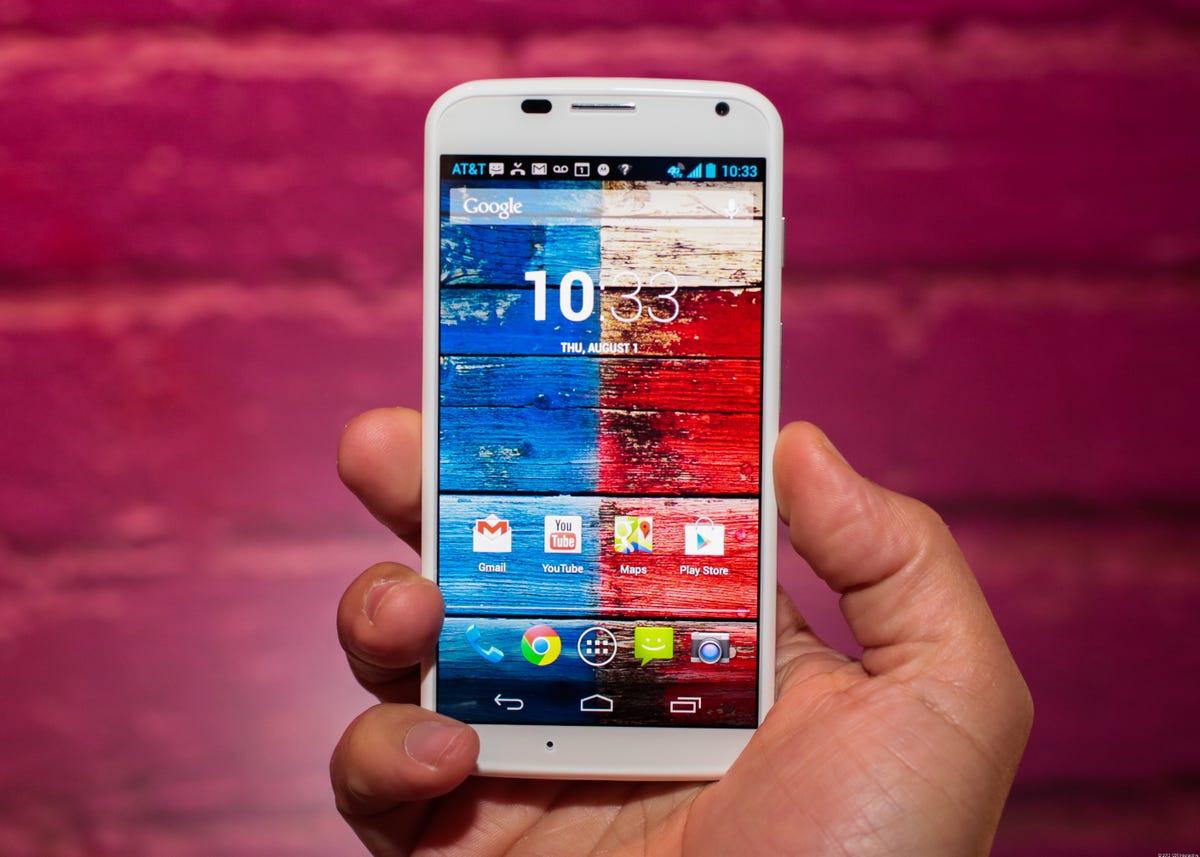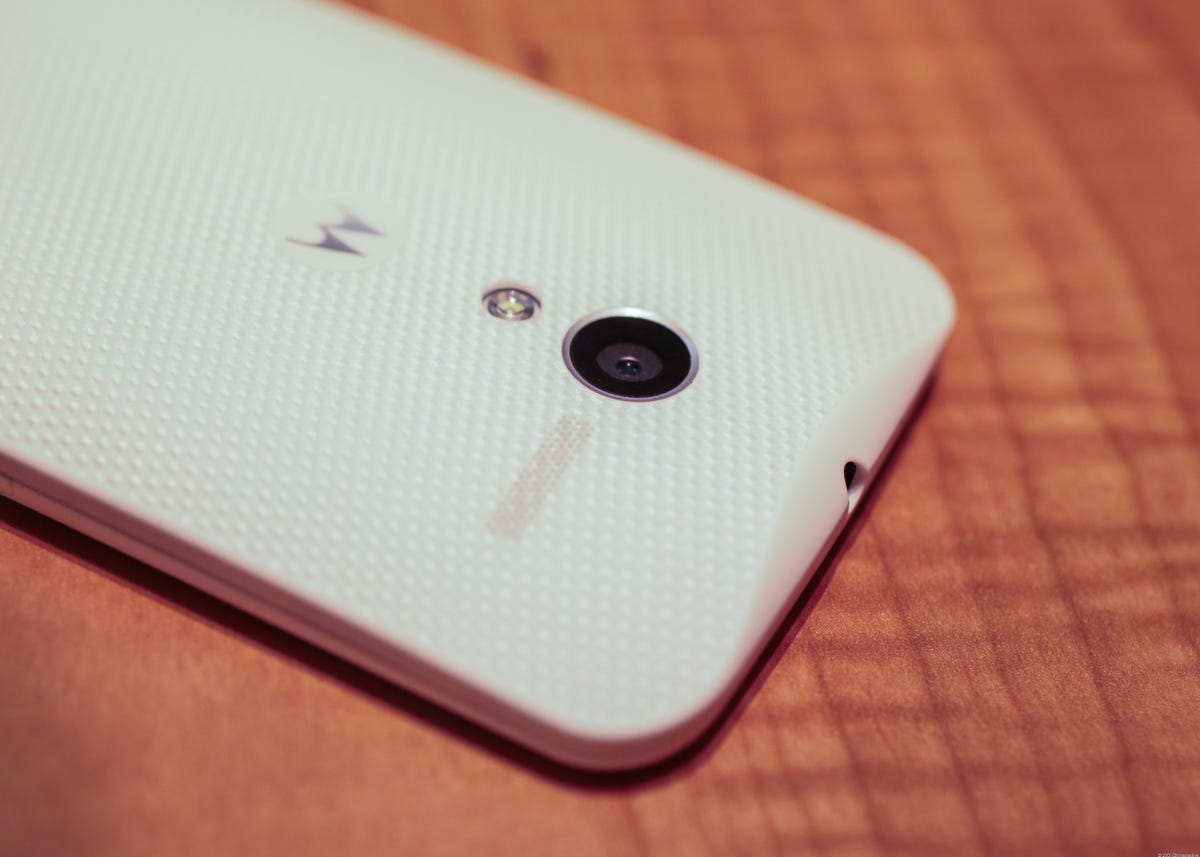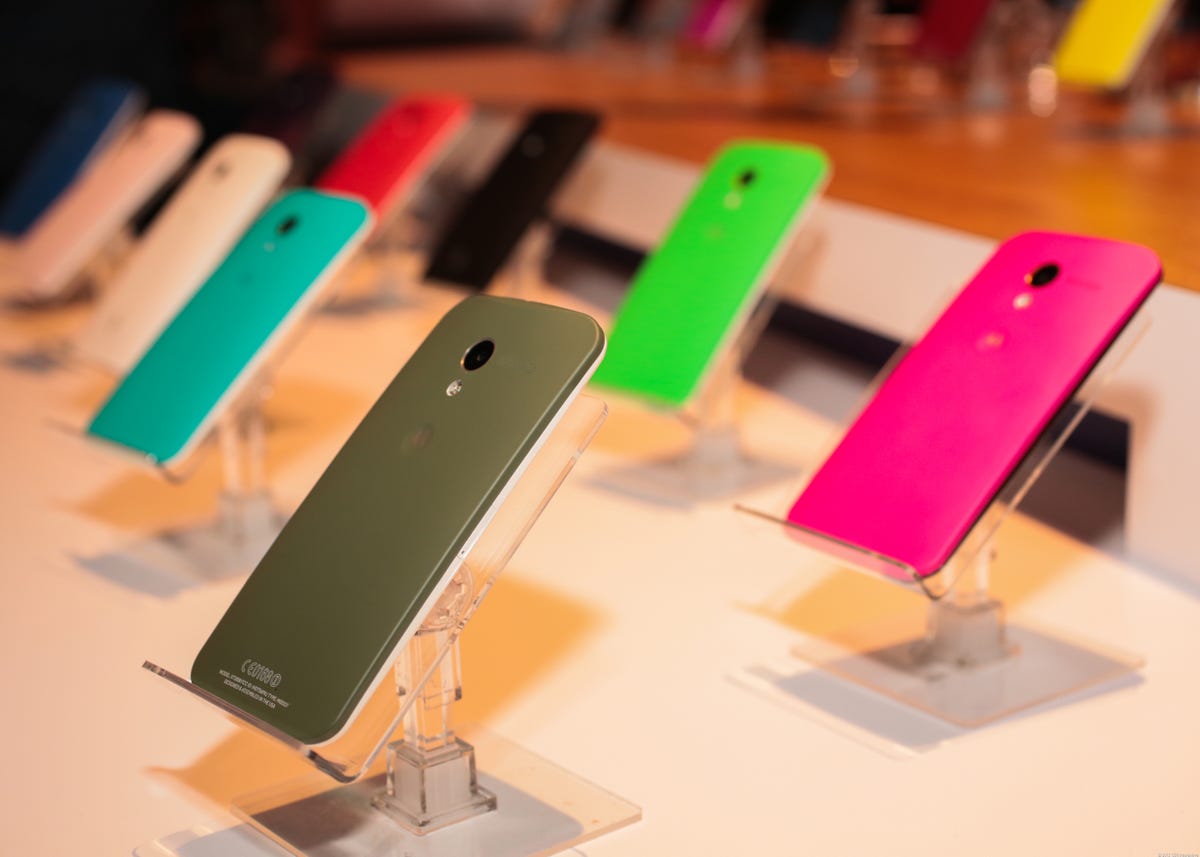

Now playing:
Watch this:
Meet Motorola’s new Moto X
4:26
Motorola came on strong in announcing the Motorola Moto X, a smartphone that promises innovative design and features, including more awareness of the world around it than any other smartphone, and some customized design you can use to make your phone unique without resorting to a case.
Yet for all of Motorola’s claims, the Google company’s new flagship phone doesn’t immediately blow away its toughest competition, the dominating Samsung Galaxy S4. Here’s how the two line up.
All about the Moto X
- Moto X: Magical features aimed to please everyone (hands-on)
- Moto X: The first true anti-iPhone
- Motorola’s flagship phone, the Moto X has arrived
- Meet the might Moto X (pictures)
Design and build
A shorter phone than the jumbo-size Galaxy S4, the Moto X has an arched, rather than flat, back, which helps make it comfortable in the hand. The rounding is noticeable when you place it on the table; it curves up to form a smile.
There are interesting dips and dimples, and a depression in the Motorola logo where you can comfortably put your hand. A matte, soft-touch finish keeps smudges off the patterned finish, and keeps the phone from slipping in your hands.
There are also onscreen navigation controls instead of physical or capacitive buttons. On the whole, the X looks and feels more premium than the slick, high-gloss S4.
Like the Galaxy S4, the Moto X comes in white and black shades that you can dress up with more-colorful covers and back plates.
Motorola’s main personalization play is the bamboo, teak, ebony, and rosewood backings you’ll eventually be able to buy through the Moto Maker Web site. Colored cases in vibrant shades will also help make a statement. Samsung’s major contribution to differentiating its device is the aftermarket S View Cover.
Meet the mighty Moto X (pictures)






+22 more
Screen
Motorola’s relatively petite Moto X has a 4.7-inch AMOLED display with a 720p HD resolution (1,280×720 pixels). Contrast that with Galaxy S4’s larger, 5-inch screen and full 1080p resolution.
For pixel density counters, that’s a 312ppi for the Moto X versus the Galaxy S4’s 441ppi. While the Galaxy S4 may make fine lines, magnified text, and some images look a little sharper, the Moto X should still look clear and not cloudy.
Cameras
The Moto X also comes in with a lower megapixel count on the camera front, but before you discount the newbie’s photographic competence, keep in mind that megapixels don’t always translate into better picture quality.
The new Moto X’s 10-megapixel shooter uses a technology called Clear Pixel, which promises to let in 75 percent more light for more accurate sunlit and nighttime photos. As with the trio of new Verizon-bound Droids, you can shake the Moto X to wake up its camera.
For Samsung’s part, its 13-megapixel camera comes with a basket full of preset modes and playful options, including a setting to combine photos from the front- and rear-facing cameras.
Motorola’s phones’ image quality has, in the past, been shaky at best. It’s really going to need to deliver clear, crisp, and colorful photos if it’s to even approach Samsung’s generally good quality. We’ll spend plenty of quality time comparing these shooting features in the future.

Sarah Tew/CNET
OS and apps
Like the Galaxy S4, Motorola’s X runs Android 4.2.2 Jelly Bean. Unlike Samsung, the Moto X hews closer to stock Android, with three onscreen capacitive navigation controls. However, there are some elements that are all Motorola’s own.
The active display element called Peek is the most obvious. Notifications pop up on the lock screen; holding the alert bubble brings up more details, like the message interior, even when the phone is locked. Sliding up opens the app. (Note: this Peek is unrelated to the BlackBerry 10 OS feature of the same name.)
Samsung’s TouchWiz interface brings a plethora of extra settings and is highly customizable, but it’s also a tangle to work through and really get to know — so much so, we wrote an e-book guide for new owners.
We didn’t have a ton of time digging into Motorola’s custom Android layer during our hands-on session, but there appear to be options that go along with some of its unique new features.
Extras
Contextual awareness is what Moto hopes will be the X’s not-so-secret weapon, namely the touchless control that lets you talk to the phone while it’s asleep and launch searches, calls, and directions when you say, “OK, Google Now.”
This is slightly more advanced than using Google Now on other Android phones like the S4, which you have to activate with a tap before speaking. The same goes for Samsung’s S Voice app.
The S4 still has its own touchless controls with eyeball and hand gestures that have much more fringe uses, like answering calls with a wave, advancing music, and pausing video. There’s also a hardware IR blaster that you can use as a TV remote control.


Sarah Tew/CNET
Processor
The Moto X uses the same X8 processor as Verizon’s new Motorola trio. Essentially, the X8 is a mashup of a customized 1.7GHz Qualcomm Snapdragon S4 Pro chipset and two digital signal processors. Motorola claims this helps keep power consumption very low.
In the U.S., a 1.9GHz quad-core Qualcomm Snapdragon 600 processor powers the Galaxy S4. In some international markets, you can get a 1.6GHz 8-core Samsung Exynos processor running the show.
Battery life and storage
Motorola says its embedded 2,200mAh battery yields 24 hours of battery life, compared with Samsung’s 2,600mAh removable battery, which will last a full workday, but will definitely not hold on for a full calendar day.
Motorola has excelled at long-life batteries in its recent phones, so it’s safe to expect this one to deliver.
One thing to note: The Moto X does not have a microSD card slot, but the Galaxy S4 accepts up to 64GB in external storage.
Price and availability
The Moto X will launch with five U.S. carriers: AT&T, Verizon, T-Mobile, Sprint, and U.S. Cellular. You can buy the 16GB model in all-white or all-black in-store, for $199 with a two-year contract (T-Mobile’s off-contract price will vary.)
If you’re buying a custom unit through the Moto Maker Web site, you can also choose a 32GB version for $249 with a two-year contract. Carriers will announce the phone’s exact availability for the end of August and early September range. Unlocked versions will also make an appearance in the future.
Interestingly, AT&T customers will be the U.S. users who can access Moto Maker.
Samsung’s 16GB Galaxy S4 also sells for $199 on contract, and is available with a few more no-contract carriers besides.
The takeaway message (for now)
Motorola is coming on strong with the Moto X, positioning it as a premium phone. There’s no reason at this untested stage to believe that it isn’t. The screen is still large enough to comfortably navigate; and the processor, battery life, OS, and build all appear to be in tip-top form.


Sarah Tew/CNET
Even though it may sound less capacious, the 10-megapixel camera could very well produce some terrific shots (just look at the HTC One’s 4-megapixel UltraPixel setup and the Nokia Lumia 1020’s 5-megapixel versions of high-res photos).
The Moto X may not be able to change your TV channel, but it does offer some compelling extras in the way it handles alerts through Peek, and with the touch-free voice commands with Google Now.
Motorola’s options for customizing the hardware design will also appeal to customers’ sense of individuality. I personally think it’s a creative move.
The camera quality is still in question, though, based on Motorola’s track record so far, and if Google stops short of throwing its tremendous marketing clout behind it, Samsung has all the advantage.
In an uphill battle against prime rivals, Motorola’s Moto X at least has a shot at making a dent.



